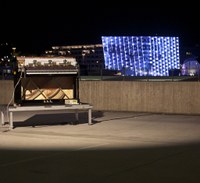Heptapiano - piano space for 7 automatic piano players
Realized at Atelier Algorythmics, Winfried Ritsch, 2011
Piece for seven robotic piano players, 27min in the series of “social machines”
Seven pianos placed in a circle of 20 meter diameter, forming a heptagram, are networked and form a piano space of 314m². With the new series of robotic piano player “Rhea” the 88 fingers on each of the seven pianos forms together a mass of 616 possible parallel playbale notes, which can be performed by the Autopianoplayer, and controlled via Ethernet from a central Control and mixing station.
They play together a composition where out of more or less chaotic behavior, like waves, little phrases as melodies and accords come to life, organizing and synchronizing themselves over the pianos. So an organic corpus of sound is formed and transformed and can be mixed live from a main control station. Synchronization and increasing differences are computed within mutation algorithm in the algorithmic composition. All this is surrounded by an endless composition “Evolution 3”, where melodies drift over the piano like the where in a big 2D spatialization space.
---
Sieben Pianinos, die im Kreis mit einen Durchmesser von ca. 20m aufgestellt werden und ein Heptagramm mit einem "piano space" bilden werden je von einem Automatenklavierspieler Rhea gespielt. Die jeweils 88 Finger der Rheas ergeben 616 parallel dynamisch spielbare Klaviernoten, welche von einer zentralen Steuereinheit als ein Klavier(raum) gespielt werden kann. Mittels eines ambisonischen Algorithmus lassen sich Melodien im Kreis und im Klavierraum dynamisch spatialisieren und wandern.
Eine reaktive algorithnmische Komposition, als Klangrauminstallation, oder auch Live algorithmisch generiert, ergibt sich aus einen mehr oder weniger chaotischen Spiel kurzer Melodie-Phrasen, komplexer Akkorde und wellenförmige Panoramisierungen und damit sich selbst über die Grenzen der einzelnen Klaviere hinweg organisieren und synchronisieren. So entsteht ein organischer musikalischer Korpus.
In Linz zur Ars electronica wurde das Publikum von der theoretisch unendlichen Komposition "Evolution 3" umspielt, bei der sich Melodien in dem 2D-panoramischen (ambisonischen) Klavierraum bewegen, basierend auf Hauers 38.Trope "die Wellen umspülten mich".
Lentos, Auditorium 19:30: Winfried Ritsch (AT): Heptaklavier
see also
| [rubra] | Foto rubra for ars electronica from http://flic.kr/p/ajpQ31 |

